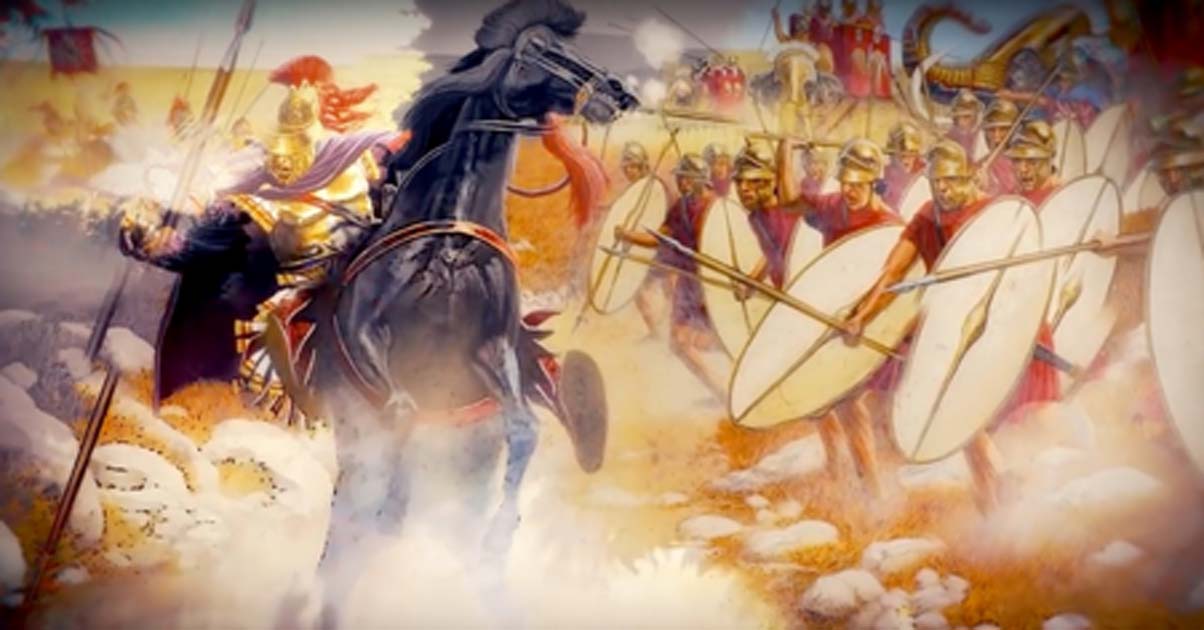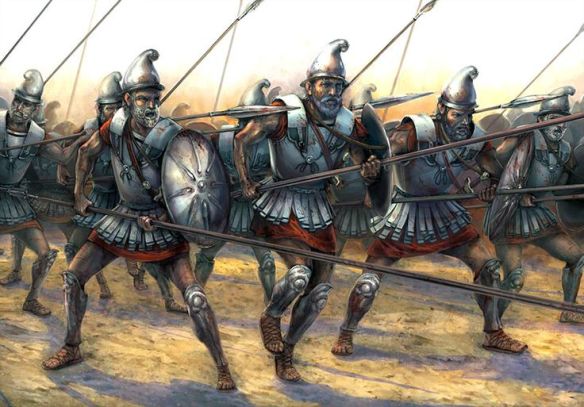Second picture is
Thracian medium cavalry.These would have accompanied Lysimachus in numbers and represented the most reliable of the allied cavalry.While well armoured they prefered skirmishing with their short javelins before charging in contrast to the massed shock approach with lance of the heavy companion cavalry.
Heavy companion hetairoi cavalry.During the Diadochi wars the former royal companion arm broke up with contingents joining each faction.
Each contender raised his own companion force,formed of his best heavy cavalry force and his closest friends and retainers.This would have been the
antigonid trump card and they enjoyed a significant advantage in heavy cavalry of this type.Armed with xyston long lance and armour as well as a xiphos or machaira for close combat,mounted on the best horses they charged in wedge formation.
Finally,both sides possesed the
war elephant -the one new element in hellenistic warfare .Alexander’s veteran generals didn’t forget the mauling the phalanx took at hydaspes to these beasts and each had when possible tried to raise an elephant force.The antigonids deployed 75 such elephants,but here the allies had a potential trump card in the 400+ war elephants seleucus recieved from Chandragupta and brought to the battlefield.
War elephants were typically
fitted with a tower on their back that housed several soldiers armed with sarissae and projectiles (arrows or javelins) to unload on the enemy. The rider (indian mahout) sat across the neck and guided the elephant into battle. Armour too, was sometimes wrapped around the elephants to protect them and increase the natural defense offered by the thickness of their hides.It could be
used as both a mobile missile platform and a shock assault weapon.A frontal charge against the massed pikes of the phalanx however was unlikely to succeed.Yet, if used for a frontal assault, the danger of them being routed and falling in panic into the lines of their own army was great.A very important factor was that the elephants were a deterrent to heavy cavalry.
Horses were terrified by the size and smell of these beasts and would not go near them,in any case they could not do anything against the height and bulk of an elephant.
Elephants when able were
provided with armour to protect them against projectiles.Light infantry projectiles aiming at the elephants head or its mahout were an effective method of bringing down these behemoths.To protect elephants from this type of harassment,they were provided with an
infantry guard of 50 men.The elephants were organized in battlegroups of 16 .It is important to remember elephants were
herd animals and as long as the herd leader was in action the pack could perform splendidly,but if the herd leader was killed was liable to panic unless very well trained.
BATTLE OF IPSUS
Ipsus was to be
in terms of numbers alone the
greatest battle of the hellenistic era(even larger in scale than gaugamela).The nearly 200,000 men gathered on the field would never have seen such a concentration and never would again.In terms of the men involved it was to be a
generational thing.The
last of Philip’s generation -Antigonus was there.As were men of
Alexander’s generation -Lysimachus,Seleucus.Among Demetrius’s companions also rode a young
18 year old Pyyrhus of Epirus – one day to be the nemesis of Rome and Carthage in Italy and Sicily,and a great tactical influence on Hannibal.The results were to be decisive – it represented the last chance to reunify Alexander’s world empire.
Tactically, both sides faced the common problem of the wars fought amongst the Successors;
how to defeat an army equipped in the same manner and using the same basic tactics. The Diadochi seem to have been inherently conservative, and continued to favour a strong attack with cavalry on the right wing of the battle-line (tactics commonly used by both Philip and Alexander) as the principal tactical thrust— even though they must have been aware of the likelihood their opponents would perform the same manoeuvre on the opposite side of the battlefield. When armies were numerically even and deploying the same tactics, gaining a clear advantage was difficult. The use of novel weapons such as war elephants and scythed chariots to change the tactical balance was one approach used by the Diadochi. Thus both sides at Ipsus had war elephants, although thanks to Seleucus, the allies were able to field an unusually high number.
Both sides therefore sought an open battlefield; the allies in order to use their elephants to full potential, and the Antigonids to allow full use of their strong cavalry arm.For the Antigonids, strong in both infantry and cavalry, the tactical situation was straightforward, and followed the template Successor tactic of a massive cavalry assault on the right wing. For the allies, weaker in infantry, the tactics would have been to maximise their overwhelming superiority in elephants.
Both sides deployed their troops in a
standard Macedonian formation, with the phalanx of heavy infantry in the centre of the battle line. In front, and to the sides of the phalanx, light infantry were deployed to act as skirmishers and to protect the flanks of the phalanx; cavalry was split between the two wings. In the Antigonid line, Demetrius commanded the best of the cavalry, stationed on the right wing. Antigonus, with his personal bodyguard was positioned in the centre behind the phalanx. The 75 elephants were deployed in front of the battle-line with their infantry guards.Antogonids also
deployed caltrops on the ground to prevent an elephant charge in front of the phalanx.
The allies split their cavalry evenly,with light infantry and horse archers screening the phalanx and 100 elephants spread out on the front line.The thracian cavalry was on the right flank,with some of the companions and mostly iranians on the left.
Seleucus in an unprecedented move,it seems held back the bulk of his elephants 300 or more in huge reserve behind the phalanx.This unique use is difficult to understand.Most probably,seleucus being the only senior commander present with extensive experience in elephant warfare having just fought 2 years against the Mauryans and their huge elephant armies wished to employ some of those lessons here.
THE BATTLE ITSELF : (above diagram)
Opposing war elephants and their supporting infantry collide on the antigonid left as the allied force advances to engage his elephant screen.
The remaining allied elephants advance and the antigonid light infantry on the centre.
Demetrius launches his cavalry assault and routs antiochus’s allied horsemen.He is unable to rein in his horsemen who chase the enemy too far and his cavalry becomes detatched from the main body.
1.The combined elephant and light infantry drive back the antigonid light infantry screen on their right flank.On the left the
rival elephant forces engage in a furious but inconclusive duel .Its a stalemate.Diodorus –
“the elephants of Antigonus and Lysimachus fought as if nature had matched them equally in courage and strength”
2.Having forced back the antigonid light infantry.The elephants and allied light infantry exploit the gap created by demetrius’s departure and begin to harass the antigonid right phalanx with persistent missile fire.The elephants don’t advance to make a physical assault because they are too few in number and traps.
3.Seleucus sees the rout of his cavalry and
redeploys his massive elephant reserve to face demetrius.Demetrius finally manages to regroup his cavalry and
returns to attack the allied rear,but finds an impenetrable wall of 300 war elephants barring his way.He takes heavy missile fire from the elephant towers and his horses are panicked by the smell and sight of these behemoths.
4.The main allied phalanx and right wing cavalry advance.
1.The phalanxes engage in close combat.Sarissa against sarissa in the classic
push of pike.Antigonids have the advantage here.
2.The antogonid
exposed right flank is compromised as the horse archers and peltast light infantry infiltrate to the flank and rear of the phalanx and begin to bombard it with javelins.The demoralized phalangites begin to retreat or desert to the allied side.
3.Antigonus moves to the left to personally try and stem the tide,waiting desperately for demetrius to arrive.But
he is killed by a javelin.
4.Hearing of Antigonus’s death,the
antigonid line crumbles and breaks.
Demetrius eventually returns finds it is hopeless and flees with his remaining horsemen.
AFTERMATH –
The allied host lost perhaps 3000 men,in return the entire antogonid army had deserted,dispersed killed or taken prisoner.
The victors curved up antigonid realms,Demetrius fled but his son was later able to establish an antigonid dynasty in original macedon.Seleucus founded the massive Seleucid empire.He came to be known as the
‘elephant king’.Lysimachus was later killed in another succesor war against Seleucus.Ipsus marked the
end of any attempt to unify alexander’s empire.
The successor dynasties would continue to rage on and off wars over territory for more than one and half a century until they were all destroyed by a new player-
The rising power of Rome.
BATTLE ANALYSIS :
1)Economy Of Effort- This is the common principle of war,the other side of the principle concentration of effort.
Seleucus
used his elephants with maximum efficiency.Using just the amount needed to neutralize the antigonid elephant screen and pepper the phalanx,allowed him to concentrate the bulk of his elephant force where he needed it.
”
Economy of force is the reciprocal of mass. It requires accepting prudent risk in selected areas to achieve superiority — overwhelming effects — in the decisive operation.”-US army doctrine based on writings of
Karl von clausewitz.
2)
Surprise – Another common principle of war,seleucus surprised his enemy with his elephant reserve.Antigonus possibly expected a massive frontal elephant charge that never came.
3)Patience- The allied commanders patiently checkmated the antigonids.Only after neutralizing first the elephant screen,then the light infantry and foremost the cavalry threat and with the phalanx deserting did they make their decisive attack.Instead of a rash frontal assault against a prepared enemy,the elpehants were used judiciously as mobile fortresses to punish the enemy.
4)Lack of Antigonid Reserve – The antigonids
lacked a reserve body to deal with the light infantry and horse archers that turned their flank which they didn’t possess.Unlike the allies who had elephants to shield their weak flank.
5)Demetrius’s Delay- Demetrius’s
failure to reign in his cavalry immediately after the succesful charge may also have helped in buying time for elephant wall to deploy.

www.ancient-origins.net








![[IMG]](/proxy.php?image=https%3A%2F%2Fi1.wp.com%2Fi.imgur.com%2FrkpW9Nx.png&hash=599a9af096a70e2361f228d1bd8b62a5)
![[IMG]](/proxy.php?image=https%3A%2F%2Fi2.wp.com%2Fi.imgur.com%2FOW4dY3L.jpg&hash=168467f9b67469b27a24743fd454bc5e)
![[IMG]](/proxy.php?image=https%3A%2F%2Fi1.wp.com%2Fi.imgur.com%2FvHBqYCd.jpg&hash=98a7b1b2407f45d5c86e5304a4dbe93f)
![[IMG]](/proxy.php?image=https%3A%2F%2Fi0.wp.com%2Fi.imgur.com%2FNhr670F.jpg&hash=4d287e196de83b05e148015ad1ada55b)
![[IMG]](/proxy.php?image=https%3A%2F%2Fi2.wp.com%2Fi.imgur.com%2FerTDyRd.jpg&hash=7538df092abd24b7d2d4d9de37c7f962)
![[IMG]](/proxy.php?image=https%3A%2F%2Fi1.wp.com%2Fi.imgur.com%2FYaocjBL.jpg&hash=98c78245df924131dda32b7af0d69d07)
![[IMG]](/proxy.php?image=https%3A%2F%2Fi0.wp.com%2Fi.imgur.com%2FsgZHV02.jpg&hash=2ab5134d54ebb8d4d36de1162701a3c0)
![[IMG]](/proxy.php?image=https%3A%2F%2Fi2.wp.com%2Fi.imgur.com%2FckNB5xh.jpg&hash=a5bc101470f3525e461fb65363762f96)
![[IMG]](/proxy.php?image=https%3A%2F%2Fi2.wp.com%2Fi.imgur.com%2F8ipAvhf.png&hash=15ff7e91099af36d0a8e25ef1e9d9a3c)
![[IMG]](/proxy.php?image=https%3A%2F%2Fi2.wp.com%2Fi.imgur.com%2FKQMFmHK.jpg&hash=e4e2fcf6a2f9d4c723bdc34746f89548)
![[IMG]](/proxy.php?image=https%3A%2F%2Fi1.wp.com%2Fi.imgur.com%2Fn0bnoGE.jpg&hash=374b8001619eabe17e820a1db0e5fb5f)
![[IMG]](/proxy.php?image=https%3A%2F%2Fi2.wp.com%2Fi.imgur.com%2FhLhDM38.jpg&hash=e3f0884f66d0bf56b84ac99be248b25d)
![[IMG]](/proxy.php?image=https%3A%2F%2Fi2.wp.com%2Fi.imgur.com%2F3VzUmqh.jpg&hash=c1e688f35d9ce38405ec8cbb7340f840)
![[IMG]](/proxy.php?image=https%3A%2F%2Fi0.wp.com%2Fi.imgur.com%2Fz6jt3XD.jpg&hash=1b645a74b2ecf9ad03f901e3926c9f24)
![[IMG]](/proxy.php?image=https%3A%2F%2Fi2.wp.com%2Fi.imgur.com%2FV63ErIr.jpg&hash=b80579b5ae63a0bed6175b26fa0c37b4)
![[IMG]](/proxy.php?image=https%3A%2F%2Fi2.wp.com%2Fi.imgur.com%2Ft23MUbV.png&hash=522ad84d8d6d22516b67bdb18e82dba9)
![[IMG]](/proxy.php?image=https%3A%2F%2Fi1.wp.com%2Fi.imgur.com%2FfbGtZ9C.jpg&hash=2a9f93ec4b2a48b1dbaf7738f29460ad)
![[IMG]](/proxy.php?image=https%3A%2F%2Fi2.wp.com%2Fi.imgur.com%2FTswjpkG.png&hash=81ffde23eebbfce7ff46c848220d0505)
![[IMG]](/proxy.php?image=https%3A%2F%2Fi0.wp.com%2Fi.imgur.com%2FvtrYEzB.png&hash=3fdb9b198092db67f3d72e5077988c24)
![[IMG]](/proxy.php?image=https%3A%2F%2Fi1.wp.com%2Fi.imgur.com%2F2apxZKD.jpg&hash=9ea98e91541e8e0de89b363a1d41b9c4)
![[IMG]](/proxy.php?image=https%3A%2F%2Fi0.wp.com%2Fi.imgur.com%2FTAfIOt9.jpg&hash=ccb5c7c8678e8ec3cc8141688dbb9ecf)
